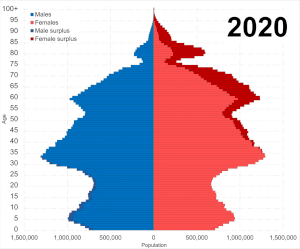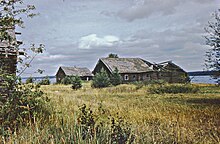Aging of Russia
This article has multiple issues. Please help improve it or discuss these issues on the talk page. (Learn how and when to remove these template messages)
|

Since the beginning of the 1990s, social and demographic changes in the Russian Federation, stemming from under the Soviet Union, led the country towards an aging population, often described in media as a "demographic crisis".[1][2][3]
History[edit]

In the economic sphere[edit]
The demographic crisis has a positive economic effect on the second stage of the changing age structure of the population (the fraction of the average working-age generation is maximal at a relatively small proportion of younger and older) and a negative economic effect on the third stage of the changing age structure of the population (when the proportion of the older generation is maximal at a relatively small share younger and middle generation). By 2025, Russia will have labor shortages.[4]
With a reduced fertility rate, the load on the working population increases because each worker has to support more retirees.[1]
Demographic aging of the population[edit]
Russia at the end of the 19th century was a country with a young population: the number of children significantly exceeded the number of the elderly. Up to 1938, the population of the Soviet Union remained "demographically young", but later, since 1959, began its demographic ageing: the proportion of young age began to decline, and the elderly – to increase, which was the result of lower fertility.[2] This was not unique to Russia, and such issues have been felt in many developed countries and increasingly in many developing countries as well.[5]

Currently, the share of people aged 65 and older in the population of Russia is 13%. According to forecasts of the Russian Academy of Sciences from the early 2000s, in 2016 elderly people aged over 60 would have accounted for 20% of Russians, and children up to 15 years would only have made up 17%. However, in Russia, in contrast to other countries, aging is limited by high mortality among older people.[2][7]
Population trends 2015–present[edit]

In 2020 however, death rates of over 500,000 people were reported due to the COVID-19 pandemic and 700,000 total deaths since the start of the pandemic. Comparing the two years, 2021 has estimated to have less of an impact on death rates but still exceeded beyond the average birth rates. President Vladimir Putin's plan to overturn the stagnation was announced in 2017 in response to the downward trend. However the plan only partially helped in their demographic crisis and was hindered by the Pandemic, despite showing signs of recovery.
| Year | Pop. | ±% p.a. |
|---|---|---|
| 1897 | 67,473,000 | — |
| 1926 | 93,459,000 | +1.13% |
| 1939 | 108,377,000 | +1.15% |
| 1959 | 117,534,000 | +0.41% |
| 1970 | 130,079,000 | +0.93% |
| 1979 | 137,552,000 | +0.62% |
| 1989 | 147,386,000 | +0.69% |
| 2002 | 145,166,731 | −0.12% |
| 2010 | 142,856,836 | −0.20% |
| 2015 | 144,985,057 | +0.30% |
| 2019 | 146,764,655 | +0.31% |
| 2020 | 146,171,015 | −0.40% |
| 2021 | 146,000,460 | −0.12% |
| Source:[9][10][failed verification][11] | ||
The natural population declined by 997,000 between October 2020 and September 2021 (the difference between the number of births and the number of deaths over a period).[12] The natural death rate in January 2020, 2021, and 2022 have each been nearly double the natural birth rate.[13]
Following the Russian invasion of Ukraine in 2022, the demographic crisis in the country has deepened,[14] as the country has reportedly suffered high military fatalities while facing renewed brain drain and human capital flight caused by Western mass-sanctions and boycotts.[15] Many commentators predict that the situation will be worse than during the 1990s.[16]
In March 2023, The Economist reported that "Over the past three years the country has lost around 2 million more people than it would ordinarily have done, as a result of war [in Ukraine], disease and exodus."[17]
According to Russian economist Alexander Isakov, "Russia’s population has been declining and the war will reduce it further. Reasons? Emigration, lower fertility and war-related casualties."[18] Russian journalist Andrey Kolesnikov noted that "We are seeing a phenomenon Russia has faced many times: wave after wave of wars and repression that drain away human resources."[19]
The UN is projecting that the decline that started in 2021 will continue, and if current demographic conditions persist, Russia’s population would be 120 million in fifty years, a decline of about 17%.[20][17]
In January 2024, the Russian statistics agency Rosstat predicted that Russia’s population could drop to 130 million by 2046.[21]
See also[edit]
References[edit]
- ^ a b Berriault, Lea (2022-01-31). "Russia's demographic setback". GIS Reports. Retrieved 2023-01-15.
- ^ a b c "Russia's Demographic Crisis | Wilson Center". www.wilsoncenter.org. Retrieved 2023-01-15.
- ^ Klomegah, Kester Kenn (2021-02-03). "Moment of Truth: Russia Faces Demography Crisis". Modern Diplomacy. Retrieved 2023-01-15.
- ^ Старостин, Алексей. "Свобода перемещения трудовых ресурсов в ЕАЭС к 2025 году". russiancouncil.ru (in Russian). Retrieved 2022-02-06.
- ^ "The EU is ageing and in need of care - here's what that might mean for its economic future". World Economic Forum. Retrieved 2023-01-15.
- ^ "Russia's decaying villages". Al Jazeera. 2 May 2014.
- ^ Timonin, Sergey; Klimkin, Ilya; Shkolnikov, Vladimir M.; Andreev, Evgeny; McKee, Martin; Leon, David A. (March 2022). "Excess mortality in Russia and its regions compared to high income countries: An analysis of monthly series of 2020". SSM - Population Health. 17: 101006. doi:10.1016/j.ssmph.2021.101006. ISSN 2352-8273. PMC 8717231. PMID 35005187.
- ^ "Russia's 'catastrophic' missing men problem". The Week. 10 May 2023.
- ^ "RUSSIA: historical demographical data of the whole country". Populstat.info. Archived from the original on 7 July 2017. Retrieved 6 July 2017.
- ^ Оценка численности постоянного населения на 1 января 2020 года и в среднем за 2019 год [Preliminary estimated population as of 1 January 2020 and on the average for 2019] (XLS). Rosstat (in Russian).
- ^ "Population of Russia 2022 | Religion in Russia". 3 May 2021.
- ^ Sauer, Pjotr (13 October 2021). "Russia's population undergoes largest ever peacetime decline". The Guardian.
- ^ "Natural population decrease in Russia down by 21% in Jan 2022 vs Jan 2021, but twice higher than in Jan 2020 - Rosstat". Interfax News Agency. 6 March 2022.
- ^ "Russia stares into population abyss as Putin sends its young men to die". The Telegraph. 26 February 2023.
- ^ Cocco, Federica; Ivanonva, Polina (4 April 2022). "Ukraine war threatens to deepen Russia's demographic crisis". Financial Times. London. Archived from the original on 10 December 2022. Retrieved 6 October 2022.
- ^ Goble, Paul (18 August 2022). "Russia's Demographic Collapse Is Accelerating". Eurasia Daily Monitor. 19 (127). Washington, D.C.: Jamestown Foundation.
- ^ a b "Russia's population nightmare is going to get even worse". The Economist. 4 March 2023.
- ^ "Putin's War Escalation Is Hastening Demographic Crash for Russia". Bloomberg. 18 October 2022.
- ^ Kolesnikov, Andrei (8 February 2023). "Russia's Second, Silent War Against Its Human Capital". Carnegie Endowment for International Peace.
- ^ "World Population Prospects 2022, Standard Projections, Compact File, Variant tab, Total Population, as of 1 January column". United Nations Department of Economic and Social Affairs, Population Division. 2022.
- ^ "Russia's Population Could Fall to 130Mln by 2046 – Rosstat". The Moscow Times. 12 January 2024.
Literature[edit]
- Демографический ежегодник России — 2008 Archived 2016-03-05 at the Wayback Machine
- Демографический ежегодник России — 2010
- Ермаков С. П., Захарова О. Д. Демографическое развитие России в первой половине XXI века. — М.: ИСПИ РАН, 2000.
- Антонов А. И., Медков В. М., Архангельский В. Н. Демографические процессы в России XXI века. — М.: «Грааль», 2002.
- Зиверт Ш., Захаров С., Клингхольц Р. Исчезающая мировая держава Archived 2019-11-27 at the Wayback Machine Берлин: Berlin Institute for Population and Development, 2011. ISBN 978-3-9812473-8-1
- Эберштадт Н. Демографический кризис в России в мирное время.
- Антонов А. И. Институциональный кризис семьи и возможности его преодоления в России (часть 1) // Демография.ру, 27.03.2011.
- Борисов В. Демографическая ситуация в современной России. Демографические исследования. 2006. No. 1.
- Залунин В. И., Калинина Т. А. Демографический кризис как социальный феномен и особенности его проявления в современной России // Труды Дальневосточного государственного технического университета, No. 132, 2002. С. 171–174.
- Левина Е. И. Институт семьи в современной демографической ситуации в России // Вестник Тамбовского университета. Серия: Гуманитарные науки, No. 12, 2008. С. 483–488.
- Луцкая Е. Е. Проблемы социально-демографического развития // Социальные и гуманитарные науки. Отечественная и зарубежная литература. Серия 2: Экономика. Реферативный журнал, No. 4, 2001. С. 104–108.
- Сулакшин С. С. Корреляционный факторный анализ российского демографического кризиса // Власть, No. 1, 2007. С. 16–28.
- Ткаченко Н. Н. Демографическая политика России в контексте национальной безопасности // Философия права, No. 3, 2009. С. 116–119.
- Николас Эберштадт. Russia's Peacetime Demographic Crisis: Dimensions, Causes, Implications
- Vladimir M. Shkolnikov, G. A. Cornia. Population crisis and rising mortality in transitional Russia. — in.: The mortality crisis in transitional economies. — Oxford: Oxford University Press, 2000: p. 253—279.
- А. Г. Вишневский, В. М. Школьников. Смертность в России. Главные группы риска и приоритеты действий. — М.: Московский Центр Карнеги, Научные доклады, Вып. 19, 1997
- Белобородов И. И. Социальные технологии формирования семейно-демографической политики в России в условиях демографического кризиса // Диссертация на соискание учёной степени кандидата социологических наук / Российский государственный социальный университет. Москва, 2008.
- Моисеев М. Демографический кризис: в чём видят выход государство и Церковь // Официальный сайт Московского Патриархата Русской Православной Церкви, 16.05.2006.
- Рязанцев С. В. Эмиграция женщин из России. Доклад на круглом столе «Семья и будущее цивилизаций» Мирового общественного форума «Диалог цивилизаций» (7—11.10.2010 г., Греция).
- Демографическая доктрина России: Проект для обсуждения (Руководитель разработки — Ю. В. Крупнов) // Институт мирового развития, Москва, 2005.
